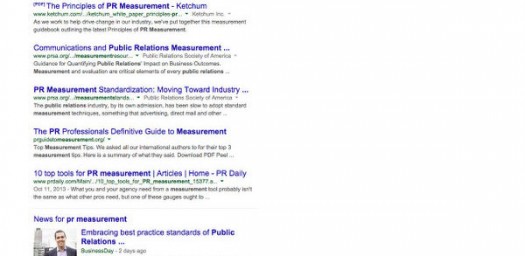You feel pressure to include data in your reports, right? You’re not alone.

As PR professionals we’re expected, not unreasonably, to provide justification for our existence and include data in our project reports. However much of what we’ve been trained to focus on has changed, or is changing—and so are the methods of PR measurement.
We’re under the gun to provide results these days and, more and more, to tie our work to bottom line business goals. According to PRSA, “measurement and evaluation are critical elements of every public relations practitioner’s professional competencies and are central to making a ‘case’ for public relations.”
However, it can be confusing to understand what’s changed, what’s expected and how to get started.
Google the terms “PR” and “measurement” and you’ll come up with a wide range of information. Everything from PRSA’s efforts to develop best practices for using statistics to Mashable’s recent post providing directions on How to Shift PR From Vanity Metrics to Value-Driven Measurement.

In a post for PR News, Kami Huyse, founder of social media and communications firm Zoetica Media, describes the changes taking place within traditional media as creating a move toward center stage for digital media.
As a result she writes, “…public relations has been asked to go directly to a company’s stakeholders with its own brand of digital journalism and social media outreach.”
PR is being “…asked to measure the results of that outreach in dollars and cents, which has caused a huge crisis for the profession to find ways to adequately meet the demand,” according to Kami.
So where do you start when you’re charged with launching a measurement campaign for your organization? You go to the beginning.
Remember the five W’s and the H? Those questions we were all taught to answer as part of our communications efforts? Well, they still apply and answering these six key questions before you start your PR measurement efforts is the best way to start. Here they are:
What are you trying to accomplish?

Although most people assume public relations is synonymous with publicity, the field includes many different practice areas including crisis communications, employee communications, event management, integrated marketing communications and investor relations. Your practice area will impact the objectives of your campaign as will the business goals of the organization or client you are working with. Answer that first “W” before you go any further.
Who are you trying to reach?

Next, identify your target audiences. Who are they? Know who you’re trying to reach and what they consider important. Who are the people they consider influential? Who do they listen to or talk about?
Where do you find them?

Identify where you’ll find your target audiences, both online and offline. This is crucial since your measurement will involve monitoring the conversations and related actions your audiences take in response to your communications.
Why are you measuring?

What do you hope to achieve with your measurement? How will you use the information you glean? The data you glean can be used for many purposes, including justifying the campaign direction, tweaking the tactics you’re using, updating materials and programs, identifying new audiences and more.
When do campaigns start and end?

What’s the timeframe for this project? Lay out the timetable from start to finish and make sure to include the time you’ll to evaluate and report on your results.
How will you know success?

Develop your goals and objectives before you launch your campaign and make sure you make them SMART (Specific, Measurable, Actionable, Relevant and Timely). If you’re new to developing SMART goals and objectives, you may find this worksheet from the PRSA Measurement Toolkit helpful.
These tried and true six questions will provide you with a place to start and help you build a foundation for your PR measurement efforts. The evolution of PR and measurement continues, so stay tuned and measure well!
Allen Mireles is a strategist with an affinity for technology who lives/works at the intersection of social media and traditional marketing/public relations. Want to read more from Allen? Click here!
Image: Kristy Hall, Crystal, Helga Weber, William Murphy, Ana Vignet, Rachael Towne, Flazingo Photos (Creative Commons)![]()

